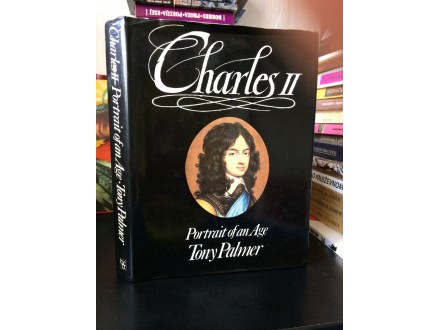CHARLES II - Portrait of an Age - Tony Palmer
| Cena: |
| Želi ovaj predmet: | 3 |
| Stanje: | Polovan bez oštećenja |
| Garancija: | Ne |
| Isporuka: | BEX Pošta DExpress Post Express Lično preuzimanje |
| Plaćanje: | Tekući račun (pre slanja) Ostalo (pre slanja) Pouzećem Lično |
| Grad: |
Novi Sad, Novi Sad |
ISBN: Ostalo
Godina izdanja: 1979
Jezik: Engleski
Autor: Strani
odlično stanje, unutra kao nova
Charles II: Portrait of an Age
Tony Palmer
Tony Palmer (born 29 August 1941 in London)[1] is a British film director and author.[2] His work includes over 100 films, ranging from early works with The Beatles, Cream, Jimi Hendrix, Rory Gallagher (Irish Tour `74) and Frank Zappa (200 Motels), to his classical portraits which include profiles of Maria Callas, Margot Fonteyn, John Osborne, Igor Stravinsky, Richard Wagner, Yehudi Menuhin, Carl Orff, Benjamin Britten and Ralph Vaughan Williams. He is also a stage director of theatre and opera.
Among over 40 international prizes for his work are 12 Gold Medals from the New York Film Festival as well as numerous BAFTAs and Emmy Awards. Palmer has won the Prix Italia twice,[3] for A Time There Was in 1980 and At the Haunted End of the Day in 1981. He is a Fellow of the Royal Geographical Society, and an honorary citizen of both New Orleans and Athens.
Born Under a Bad Sign (1970)
The Trials of Oz (1971)
Electric Revolution (1971)
The Things I Love – Liberace (1976)
All You Need Is Love (1976)
Charles II: Portrait of an Age (1979)
Julian Bream: A Life on the Road. London: Macdonald, 1982. ISBN 0-356-07880-9. Text by Palmer, photographs by Daniel Meadows.
Menuhin: A Family Story (1991)
Charles II (29 May 1630 – 6 February 1685)[c] was king of England, Scotland and Ireland. He was king of Scotland from 1649 until his deposition in 1651, and king of England, Scotland and Ireland from the restoration of the monarchy in 1660 until his death.
Charles II`s father, Charles I, was executed at Whitehall on 30 January 1649, at the climax of the English Civil War. Although the Parliament of Scotland proclaimed Charles II king on 5 February 1649, England entered the period known as the English Interregnum or the English Commonwealth, and the country was a de facto republic, led by Oliver Cromwell. Cromwell defeated Charles II at the Battle of Worcester on 3 September 1651, and Charles fled to mainland Europe. Cromwell became virtual dictator of England, Scotland and Ireland. Charles spent the next nine years in exile in France, the Dutch Republic and the Spanish Netherlands. A political crisis that followed the death of Cromwell in 1658 resulted in the restoration of the monarchy, and Charles was invited to return to Britain. On 29 May 1660, his 30th birthday, he was received in London to public acclaim. After 1660, all legal documents were dated as if he had succeeded his father as king in 1649.
Charles`s English parliament enacted laws known as the Clarendon Code, designed to shore up the position of the re-established Church of England. Charles acquiesced to the Clarendon Code even though he favoured a policy of religious tolerance. The major foreign policy issue of his early reign was the Second Anglo-Dutch War. In 1670, he entered into the Treaty of Dover, an alliance with his first cousin King Louis XIV of France. Louis agreed to aid him in the Third Anglo-Dutch War and pay him a pension, and Charles secretly promised to convert to Catholicism at an unspecified future date. Charles attempted to introduce religious freedom for Catholics and Protestant dissenters with his 1672 Royal Declaration of Indulgence, but the English Parliament forced him to withdraw it. In 1679, Titus Oates`s revelations of a supposed `Popish Plot` sparked the Exclusion Crisis when it was revealed that Charles`s brother and heir (James, Duke of York) was a Catholic. The crisis saw the birth of the pro-exclusion Whig and anti-exclusion Tory parties. Charles sided with the Tories, and, following the discovery of the Rye House Plot to murder Charles and James in 1683, some Whig leaders were executed or forced into exile. Charles dissolved the English Parliament in 1681, and ruled alone until his death on 6 February 1685. He was received into the Catholic Church on his deathbed.
Charles was one of the most popular and beloved kings of England,[1] known as the Merry Monarch, in reference to both the liveliness and hedonism of his court and the general relief at the return to normality after over a decade of rule by Cromwell and the Puritans. Charles`s wife, Catherine of Braganza, bore no live children, but Charles acknowledged at least twelve illegitimate children by various mistresses. He was succeeded by his brother James.
Чарлс II (енгл. Charles II of England; Лондон, 29. мај 1630. — Лондон, 6. фебруар 1685.) је био краљ Енглеске, Шкотске и Ирске од 29. маја 1660. до 6. фебруара 1685. године.
Поборници монархије сматрају да је Чарлс постао краљ де јуре смакнућем његовог оца Чарлса I, 30. јануара 1649. године. Шкотски парламент га је прогласио краљем Шкота 5. фебруара 1649. године. Крунисан је у Шкотској јануара 1651, али је после пораза у бици код Вустера 3. септембра исте године морао да побегне у избеглиштво. Наредних 9 година провео је у Француској, Холандији и Шпанској Низоземској. Званично је постао краљ 29. маја 1660. након смрти Оливера Кромвела, када га је парламент позвао назад у земљу. Тиме је завршено раздобље комонвелта и започела рестаурација монархије у Енглеској.
По повратку на престо, парламент га је нагнао да учврсти положај Англиканске цркве на рачун пуританаца, иако је сам краљ нагињао религијској толеранцији и римокатолицизму. Главни спољнополитички догађаји његове владавине били су Други и Трећи англо-холандски рат. Завереници су 1683. покушали да убију Чарса и његовог брата Џејмса у житној завери. За живота су га звали Весели монарх, јер је био познат по љубавницама и као хедониста.
Наследио га је брат, Џејмс II.
tags:
istorija engleske istorija velike britanije engleski britanski vladari svetska istorija čarls drugi...
International shipping
Paypal only
(Države Balkana: Uplata može i preko pošte ili Western Union-a)
1 euro = 117.5 din
For international buyers please see instructions below:
To buy an item: Click on the red button KUPI ODMAH
Količina: 1 / Isporuka: Pošta / Plaćanje: Tekući račun
To confirm the purchase click on the orange button: Potvrdi kupovinu (After that we will send our paypal details)
To message us for more information: Click on the blue button POŠALJI PORUKU
To see overview of all our items: Click on Svi predmeti člana
Ako je aktivirana opcija besplatna dostava, ona se odnosi samo na slanje kao preporučena tiskovina ili cc paket na teritoriji Srbije.
Poštarina za knjige je u proseku 133-200 dinara, u slučaju da izaberete opciju plaćanje pre slanja i slanje preko pošte. Postexpress i kurirske službe su skuplje ali imaju opciju plaćanja pouzećem. Ako nije stavljena opcija da je moguće slanje i nekom drugom kurirskom službom pored postexpressa, slobodno kupite knjigu pa nam u poruci napišite koja kurirska služba vam odgovara.
Ukoliko još uvek nemate bar 10 pozitivnih ocena, zbog nekoliko neprijatnih iskustava, molili bi vas da nam uplatite cenu kupljenog predmeta unapred.
Novi Sad lično preuzimanje ili svaki dan ili jednom nedeljno zavisno od lokacije prodatog predmeta.
Našu kompletnu ponudu možete videti preko linka
https://www.kupindo.com/Clan/H.C.E/SpisakPredmeta
Ukoliko tražite još neki naslov koji ne možete da nađete pošaljite nam poruku možda ga imamo u magacinu.
Pogledajte i našu ponudu na limundu https://www.limundo.com/Clan/H.C.E/SpisakAukcija
Slobodno pitajte šta vas zanima preko poruka. Preuzimanje moguce u Novom Sadu i Sremskoj Mitrovici uz prethodni dogovor. (Većina knjiga je u Sremskoj Mitrovici, manji broj u Novom Sadu, tako da se najavite nekoliko dana ranije u slucaju ličnog preuzimanja, da bi knjige bile donete, a ako Vam hitno treba neka knjiga za danas ili sutra, obavezno proverite prvo preko poruke da li je u magacinu da ne bi doslo do neprijatnosti). U krajnjem slučaju mogu biti poslate i poštom u Novi Sad i stižu za jedan dan.
U Novom Sadu lično preuzimanje na Grbavici na našoj adresi ili u okolini po dogovoru. Dostava na kućnu adresu u Novom Sadu putem kurira 350 dinara.
Slanje nakon uplate na račun u Erste banci (ukoliko ne želite da plaćate po preuzimanju). Poštarina za jednu knjigu, zavisno od njene težine (do 2 kg), može biti od 170-264 din. Slanje vise knjiga u paketu težem od 2 kg 340-450 din. Za cene postexpressa ili drugih službi se možete informisati na njihovim sajtovima.
http://www.postexpress.rs/struktura/lat/cenovnik/cenovnik-unutrasnji-saobracaj.asp
INOSTRANSTVO: Šaljem po dogovoru, ili po vašim prijateljima/rodbini ili poštom. U Beč idem jednom godišnje pa ako se podudare termini knjige mogu doneti lično. Skuplje pakete mogu poslati i po nekom autobusu, molim vas ne tražite mi da šaljem autobusima knjige manje vrednosti jer mi odlazak na autobusku stanicu i čekanje prevoza pravi veći problem nego što bi koštala poštarina za slanje kao mali paket preko pošte.
Ukoliko kupujete više od jedne knjige javite se porukom možda Vam mogu dati određeni popust na neke naslove.
Sve knjige su detaljno uslikane, ako Vas još nešto interesuje slobodno pitajte porukom. Reklamacije primamo samo ukoliko nam prvo pošaljete knjigu nazad da vidim u čemu je problem pa nakon toga vraćamo novac. Jednom smo prevareni od strane člana koji nam je vratio potpuno drugu knjigu od one koju smo mu mi poslali, tako da više ne vraćamo novac pre nego što vidimo da li se radi o našoj knjizi.
Ukoliko Vam neka pošiljka ne stigne za dva ili tri dana, odmah nas kontaktirajte za broj pošiljke kako bi videli u čemu je problem. Ne čekajte da prođe više vremena, pogotovo ako ste iz inostranstva, jer nakon određenog vremena pošiljke se vraćaju pošiljaocu, tako da bi morali da platimo troškove povratka i ponovnog slanja. Potvrde o slanju čuvamo do 10 dana. U 99% slučajeva sve prolazi glatko, ali nikad se ne zna.
Ukoliko uvažimo vašu reklamaciju ne snosimo troškove poštarine, osim kada je očigledno naša greška u pitanju.
Predmet: 48518277











